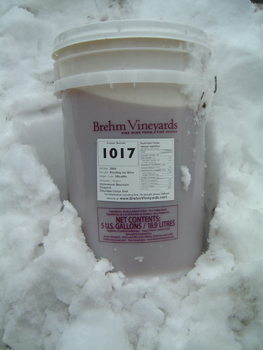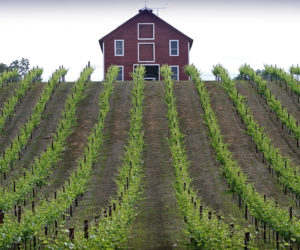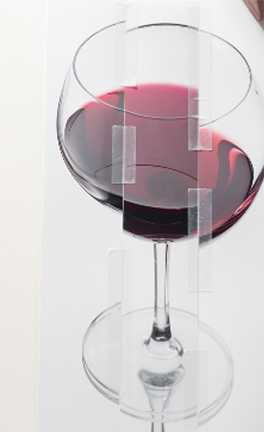 It seems a short time ago when, if you wanted to make wine, you waited for the fall harvest season when grapes would start arriving from the West Coast. Everyone would be doing basically the same thing; buying the grapes, getting their equipment ready, clearing out the space in their cellar or garage, etc. A veritable whirlwind of activity compressed into a relatively short period of time. The process would end with the aging, and finally sometime down the road, the bottling. Then you could relax and enjoy the fruits of your fermenting labor until the following wine season. After fall harvest has always been a time to reflect upon results and to plan for the following year’s vintage improvements or changes to our process.
It seems a short time ago when, if you wanted to make wine, you waited for the fall harvest season when grapes would start arriving from the West Coast. Everyone would be doing basically the same thing; buying the grapes, getting their equipment ready, clearing out the space in their cellar or garage, etc. A veritable whirlwind of activity compressed into a relatively short period of time. The process would end with the aging, and finally sometime down the road, the bottling. Then you could relax and enjoy the fruits of your fermenting labor until the following wine season. After fall harvest has always been a time to reflect upon results and to plan for the following year’s vintage improvements or changes to our process.
Then came the realization that we could do this wonderful fresh grape craziness twice a year — in the traditional autumn and in the spring with the arrival of grapes from Chile and other grape growing countries in the Southern Hemisphere. With this advent, it seems that we barely finish the fermentation and start aging the West Coast wines when it is time to get the equipment out once again for the Southern Hemisphere grapes. Each fermentation cycle we have an opportunity to hone our skills, tweak our processes and learn twice as quickly.
Ah, but wait (as they say on TV), there is yet another way to make great wines . . . anytime, with frozen musts!
You may never need to go through the agony of storing your equipment. They can become permanent fixtures, available at a moment’s notice, to start the process over and over whenever the urge to ferment gets too irrepressible.
Frozen musts are becoming more and more common with a growing list of available varietals. The list includes vinifera, hybrid and native varieties. Not only can you do this anytime during the year, but a significant portion of the winemaking process — much of the “heavy lifting” so to speak — has been done for you. Specifically, a container of frozen must is exactly what it sounds like; crushed and destemmed grapes in their own juice. Someone else has done the crushing and destemming for you. For reds, whatever comes out of the crusher/destemmer goes directly into the tub; crushed grapes, seeds, and few stems. For whites, it is normally settled juice. Either way, it is quickly frozen solid and is maintained in this state until it is sold to someone who will make wine from it.
The frozen musts can come from any region of the world as more producers are getting on board. Would you like to make a real Italian Chianti, a Gewürztraminer from Washington State, a Cabernet from Napa? A call to your grape purveyor will tell you exactly what is available and when. In general, availability of frozen specific varietals will be the same as for those same fresh grapes.
There are many advantages to working with frozen musts for beginning winemakers. Besides the advantage of anytime availability, your capital investment in winemaking equipment can be avoided, minimized, or delayed until you really want to work with fresh fruit. You do not need a crusher/destemmer, but you will still need a wine press for the red grapes, to separate the liquid from the solids. Whites are usually already in juice form. Further, frozen musts eliminate the lifting effort of loading the fresh grape lugs into the crusher/destemmer.
So to sum up, when making wine from frozen musts, we require less equipment (along with less preparation and clean up time), no need to schlep heavy grape lugs, and you can do this anytime of the year.
What about sensory attributes of the wines? In my experience, the wines produced from frozen musts rival those made directly from fresh fruit. And why wouldn’t they? When you start with good quality berries and freeze them as they are crushed or pressed, all we are doing is interrupting our fresh winemaking process with a deep freeze and restarting when it is convenient for us. Freezing a solution with organic matter in it can change the solubilities of some molecules, so the wine may not be exactly the same as a fresh grape wine, but the differences are not that great.
It gets better still; many producers identify specific source vineyards on their container labeling. Depending on producer, some frozen musts may even contain additives such as sulfites or enzymes added at the time of crushing and freezing. Some local grape purveyors provide custom freezing at the specific request of individual customers to crush/destem, add sulfites, enzymes and any other additive desired. Note, however, specific pail metrics such as sugar, pH and titratable acidity must still be determined by the winemaker when the juice is thawed since these numbers frequently may vary pail to pail. My advice to winemakers is to always take your own readings — sugar, titratable acidity and pH — regardless of what the label says! And remember to adjust your readings for temperature if your must has not yet warmed to room temperature.
How about this scenario? Your favorite grapes, from your favorite vineyard, have just arrived at the local purveyor. Unfortunately, you have other commitments at that time that cannot be altered and therefore you cannot start the winemaking process. Rather than losing the opportunity to work with those special grapes, a request to the supplier to crush, destem and freeze your grapes suddenly gets rid of the interference and you can postpone the fun for as long as needed! One such event occurred recently when a winemaker’s grapes arrived around the time of his wedding day. He ended up making the wine a few weeks after the honeymoon. It’s always important to set your priorities!
As a side benefit for winemaking clubs using frozen musts is that they can obtain several varieties at the same time which, of course, results in the ability of processing many differing varieties on the same day, regardless of harvest dates. This also simplifies the chore of multiple equipment preparations and clean up for the members.
Recognize also that the industry has not yet settled on a standard pail size for home winemakers; some may be 5 gallons (19 L) while others may be 6 gallons (23 L). Some containers will be sized metrically between 23 liters and 27 liters. If you are purchasing a red frozen must, be aware that you will probably yield about 70–80% liquid; the rest being solid material — skins, seeds, and some stems. So plan accordingly based on what quantity you want as a finished wine. For winemakers producing large quantities of wine, there are even frozen 55-gallon (210-L) drums available.
With the advent of overnight, next day and 2–3 day shipping to anywhere in the country, winemakers located in the US and Canada can receive their frozen musts still in solid — or at most, slushy — condition, thanks to modern insulated packaging.
This is a new and evolving niche segment of the industry. It may not yet be available at your local grape supplier, but is from several suppliers which have a national footprint via the internet. Peter Brehm, of Brehm Vineyards, pioneered this capability and for many years was the only source for frozen products. A select number of other purveyors such as M&M Juice Grape on the East Coast (the company I work for), have since developed similar freezing capabilities. The design of unique packaging for the frozen products and close collaboration with rapid delivery service logistics companies such as FedEx and UPS, now allow quality frozen grapes to be within the reach of any winemaker almost anywhere in North America. As always, it behooves you, as the winemaker, to develop a good relationship with your grape supplier. This will certainly help in getting frozen musts, often as a custom product requiring extra attention, and is especially true if you are at a remote location from your supplier. Most quality suppliers welcome this customer interaction as it provides an avenue to improve customer service and relations.
When it gets to the actual winemaking process, there is also an interesting benefit for red varieties. As the frozen must thaws out over a several day period, cold maceration is achieved! As the must is allowed to thaw slowly and caused to stay in a low temperature liquid state for at least four days (perhaps less in some conditions) maximum color extraction can be achieved. In addition, the tannins extracted during this time are water soluble and will be of the softer variety as opposed to the harsher, alcohol soluble variety imparted during primary and possibly post-fermentation maceration.
This benefit may also be achieved for some aromatic whites such as Gewürztraminer, Traminette, Muscat and possibly Riesling if they contain crushed and destemmed berries. In these whites aromatic extracts from prolonged skin contact may enhance the flavor and fragrance of the wine.
Once the must has reached ambient temperature, the winemaking process used should be no different than that of working with fresh grapes. Red varieties should be sulfited to attenuate the native yeast if not previously sulfited, and cultured yeast pitched after the usual 24 hour waiting period. For aromatic frozen whites containing crushed berries, the must can be pressed immediately after desired maceration time, to separate the liquid from the solids. The usual sulfating and subsequent pitching of yeast should follow your normal protocol.
My “normal” process for reds and aromatic whites is to allow the frozen must to slowly come to room temperature, perhaps over several days. This is often achieved by blanketing the tubs with bath towels, or better, furniture movers’ blankets (available from tool and hardware suppliers). The purpose of the blankets is to slow the warming process by creating an insulating thermal barrier between the must container and ambient air. Leaving the tubs in as cool an area as possible is also an advantage. During this slow warm-up, I can start the cold maceration process with some degree of confidence regarding spontaneous fermentation, stray bacterial infection or oxidation. For non-aromatic frozen whites containing skins, I will encourage a rapid thaw and press the juice from the skins as soon as the thaw has occurred.
I have found it is always a good practice to measure residual sulfites in the must and make appropriate adjustments when an extended cold maceration is planned. This residual can vary depending on the producers sulfiting protocol during the crushing process and the age or storage period of the must before you take possession.
Starting Brix, total acidity and pH readings should likewise be measured while accounting for the cold temperature of the must. (Most measuring protocols are based on room temperature). Making any necessary adjustments during this time gets these tasks out of the way early.
Once I have completed the maceration period, and the must is finally at room temperature, I start the fermentation protocol by hydrating and pitching the yeast. Selection of yeast strains should be no different than for fresh (non-frozen) musts — that is, the choice depends on grape variety and winemaker’s objectives. Similarly, the fermentation will proceed as usual with no differences caused by the original must being frozen. Indeed, I have always been pleasantly surprised by the intensity of color achieved starting with frozen musts and the inherent, easily achieved, naturally occurring, cold maceration.
The increased availability of frozen musts can enhance the winemaking experience for homewinemakers. As we say in New England, “think snow” or in this case, “think frozen must!”







